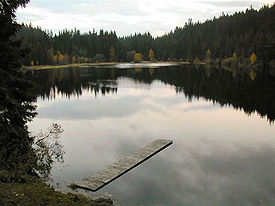
Tanner Moor
Encyclopedia

Moorland
Moorland or moor is a type of habitat, in the temperate grasslands, savannas, and shrublands biome, found in upland areas, characterised by low-growing vegetation on acidic soils and heavy fog...
s in Austria
Austria
Austria , officially the Republic of Austria , is a landlocked country of roughly 8.4 million people in Central Europe. It is bordered by the Czech Republic and Germany to the north, Slovakia and Hungary to the east, Slovenia and Italy to the south, and Switzerland and Liechtenstein to the...
with a surface area of 120 hectares. Tanner Moor is a Natura 2000
Natura 2000
Natura 2000 is an ecological network of protected areas in the territory of the European Union.-Origins:In May 1992, the governments of the European Communities adopted legislation designed to protect the most seriously threatened habitats and species across Europe. This legislation is called the...
ecologically protected area located on a high granite plateau in the Freistadt district
Freistadt (district)
Bezirk Freistadt is a district of the state ofUpper Austria, in central northern Austria.- Municipalities :Towns are indicated in boldface; market towns in italics; suburbs, hamlets and other subdivisions of a municipality are indicated in small characters.*Bad...
, Mühlviertel, Upper Austria
Upper Austria
Upper Austria is one of the nine states or Bundesländer of Austria. Its capital is Linz. Upper Austria borders on Germany and the Czech Republic, as well as on the other Austrian states of Lower Austria, Styria, and Salzburg...
at an average elevation of 900 m.
The moorland is watered exclusively by rain and is almost completely covered with pine trees
Pine
Pines are trees in the genus Pinus ,in the family Pinaceae. They make up the monotypic subfamily Pinoideae. There are about 115 species of pine, although different authorities accept between 105 and 125 species.-Etymology:...
. There are gaps, however, where typical moorland plants such as Bog-rosemary
Bog-rosemary
Andromeda polifolia, commonly known as Bog-rosemary, is a heath found across northern parts of the Northern Hemisphere. It is the only member of its genus. Bog rosemary is only found in bogs in cold peat-accumulating areas....
, Cotton-grass
Cotton-grass
Eriophorum is a genus of about 25 species of flowering plants in the family Cyperaceae, the Sedge family. They are found throughout the temperate Northern Hemisphere in acid bog habitats, being particularly abundant in Arctic tundra regions.They are herbaceous perennial plants with slender,...
and the Ericaceae
Ericaceae
The Ericaceae, commonly known as the heath or heather family, is a group of mostly calcifuge flowering plants. The family is large, with roughly 4000 species spread across 126 genera, making it the 14th most speciose family of flowering plants...
, for example upland berries (Vaccinium)
Vaccinium
Vaccinium is a genus of shrubs or dwarf shrubs in the plant Family Ericaceae. The fruit of many species are eaten by humans and some are of commercial importance, including the cranberry, blueberry, bilberry or whortleberry, lingonberry or cowberry, and huckleberry...
and heather (Calluna)
Calluna
Calluna vulgaris is the sole species in the genus Calluna in the family Ericaceae. It is a low-growing perennial shrub growing to tall, or rarely to and taller, and is found widely in Europe and Asia Minor on acidic soils in open sunny situations and in moderate shade...
, flourish. The central area of the moorland has never been used economically, but some of the areas around the edges were planted in spruce
Spruce
A spruce is a tree of the genus Picea , a genus of about 35 species of coniferous evergreen trees in the Family Pinaceae, found in the northern temperate and boreal regions of the earth. Spruces are large trees, from tall when mature, and can be distinguished by their whorled branches and conical...
in the Twentieth Century. A small dam created Rubener pond was which formerly used in lumbering, but is now just for swimming and fishing. It is a high tannin
Tannin
A tannin is an astringent, bitter plant polyphenolic compound that binds to and precipitates proteins and various other organic compounds including amino acids and alkaloids.The term tannin refers to the use of...
pond. A six kilometer long trail leads through the moorland, over bridges and past bogs to highlands of mountain pine (Pinus mugo)
Mountain Pine
Pinus mugo, the Mountain Pine or Mugo Pine, is a high-altitude European pine, found in the Pyrenees, Alps, Erzgebirge, Carpathians, northern Apennines and Balkan Peninsula mountains from 1,000 m to 2,200 m, occasionally as low as 200 m in the north of the range in Germany and Poland, and as high...
, whence the entire moor can be viewed.

